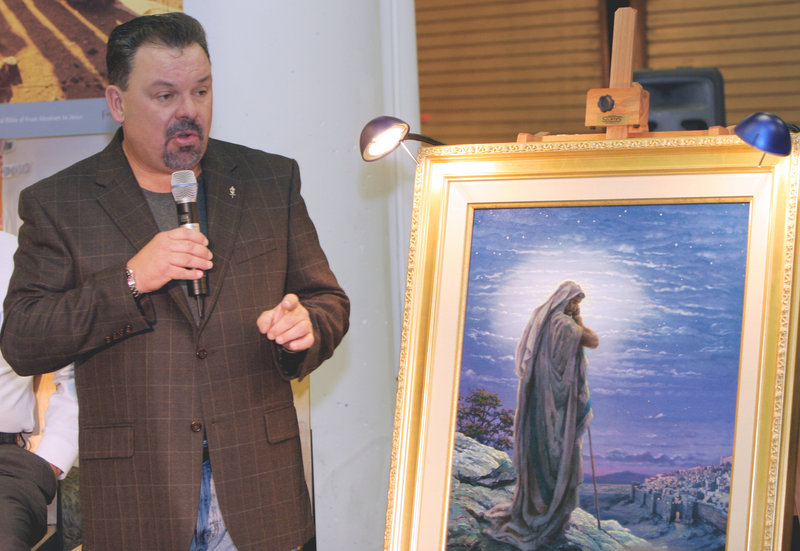SAN FRANCISCO — Artist Thomas Kinkade once said that he had something in common with Walt Disney and Norman Rockwell: He wanted to make people happy.
And he won success with brushwork paintings of idyllic landscapes, cottages and churches — highly popular works that became big sellers for dealers across the United States.
The self-described “Painter of Light,” who died Friday at age 54, produced sentimental scenes of country gardens and pastoral landscapes that were beloved by many but criticized by the art establishment.
Kinkade died at his home in Los Gatos in the San Francisco Bay Area of what appeared to be natural causes, said family spokesman David Satterfield.
There was no immediate word on an official cause of death. Calls to the coroner’s office were not immediately returned.
Kinkade claimed to be the nation’s most collected living artist, and his paintings and spin-off products were said to fetch some $100 million a year in sales, and to be in 10 million homes in the United States.
Those light-infused renderings are often prominently displayed in buildings and malls and on products. Many contain images from Bible passages.
“I’m a warrior for light,” Kinkade, a self-described devout Christian, told the San Jose Mercury News in 2002, a reference to the medieval practice of using light to symbolize the divine. “With whatever talent and resources I have, I’m trying to bring light to penetrate the darkness many people feel.”
Before Kinkade’s Media Arts Group went private in the middle of the past decade, the company took in $32 million per quarter from 4,500 dealers nationwide, according to the Mercury News. The cost of his paintings range from hundreds of dollars to more than $10,000.
According to his website, Kinkade’s paintings have been reproduced in lithographs, canvas prints, books, posters, calendars, magazine covers, cards, collector plates and figurines.
His artistic philosophy was not to express himself via his paintings like many artists, but rather to give the masses what they wanted: warm, positive images, Ken Raasch, who co-founded Kinkade’s company with him, told the Mercury News.
“I’d see a tree as being green, and he would see it as 47 different shades of green,” Raasch said. “He just saw the world in a much more detailed way than anyone I’ve ever seen.”
A biography on the website said Kinkade made “each of his works an intimate statement that resonates in the personal lives of his viewers.”
“I share something in common with Norman Rockwell and, for that matter, with Walt Disney, in that I really like to make people happy,” he said.
Kinkade was born and raised in Placerville, Calif. He studied at the University of California at Berkeley and the Art Center College of Design in Pasadena.
As a young man, Kinkade traveled by boxcar from California to New York with fellow fledgling artist, James Gurney, sketching the landscape along the way.
With these sketches in hand, the site says, the two were able to get published “The Artist’s Guide to Sketching” in 1982, helping land him a job creating background art for animated films.
He is survived by his wife, Nanette, and their four daughters.
“Thom provided a wonderful life for his family,” Nanette Kinkade said in a statement. “We are shocked and saddened by his death.”
Amid the success, though, Kinkade had run into personal difficulties in recent years.
In 2010, one of his companies filed for Chapter 11 bankruptcy. The bankruptcy filing came as the company had started making payments on an almost $3 million court award against it in a lawsuit filed by a Virginia couple, Karen Hazlewood and Jeff Spinello.
The Virginia gallery owners sued Kinkade and his company in 2003, arguing that he’d fraudulently persuaded them to invest in a licensed Kinkade gallery, according to the Los Angeles Times. The couple alleged that they were being undercut by discount sellers whose prices they were barred from matching, and they had merchandise they couldn’t sell.
The court eventually sided with the couple. Kinkade faced similar lawsuits from other owners as a number of Kinkade galleries failed from 1997 to 2005.
Marty Brown, who owns four galleries in Southern California that sell Kinkade paintings, said he hopes people remember Kinkade as not only a commercially successful artist, but also one who raised millions for charity by auctioning his works.
“We’ve got a lot of people out there today that are a little sadder today because Thomas Kinkade passed away,” Brown said Saturday, adding: “I just hope that he’s in a better place.”
Send questions/comments to the editors.



Success. Please wait for the page to reload. If the page does not reload within 5 seconds, please refresh the page.
Enter your email and password to access comments.
Hi, to comment on stories you must . This profile is in addition to your subscription and website login.
Already have a commenting profile? .
Invalid username/password.
Please check your email to confirm and complete your registration.
Only subscribers are eligible to post comments. Please subscribe or login first for digital access. Here’s why.
Use the form below to reset your password. When you've submitted your account email, we will send an email with a reset code.